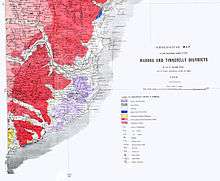Teri (geology)

Teri or Teri dune complex is a coastal landscape peculiar to some parts of Tamil Nadu mainly in southeastern India. The landscape consists of sediments dating to the Quaternary Period and made of marine deposits with aeolianite and characteristic red sand and silt dunes. These red soils are thought to have originated in the Pleistocene.[1] Robert Bruce Foote hypothesized that these dunes were created by the action of winds (aeolian) lifing the fine silt fraction from further east.[2] These dunes are oriented along the axis running parallel to the coast and between the latitudes of 8°00′ to 9°30′ N and longitudes 77°18′ to 79°00′ E. The soils also have calcium deposits replacing the old roots of vegetation.[3] The soil is rich in ilmenite and the red colour is derived from haematite originating from garnet.[4][5][6]
References
- ↑ Alappat, Linto; Palaniandy Seralathan, Anil D. Shukla, Kyth Pillai Thrivikramji, Ashok Kumar Singhvi (2013). "Chronology of red dune aggradations of South India and its Palaeo-environmental significance". Geochronometria. 40 (4): 274–282.
- ↑ Foote, Robert Bruce (1883). "On the geology of the Madura and Tinnevelly Districts. Chapter 10.". Memoirs of the Geological Survey of India. 20: 87–90.
- ↑ Hendry, D.A. (1987). "Silica and calcium carbonate replacement of plant roots in tropical dune sands, SE India". 35: 309–319. doi:10.1144/GSL.SP.1987.035.01.21.
- ↑ Gardner, Rita A. M. (1981). "Reddening of dune sands—evidence from southeast India". Earth Surface Processes and Landforms. 6 (5): 459–468. doi:10.1002/esp.3290060506.
- ↑ Kurian, N.P. ; T.N. Prakash; F. Jose and K.P. Black (2001). "Hydrodynamic Processes and Heavy Mineral Deposits of the Southwest Coast, India". Journal of Coastal Research. 34: 154–163.
- ↑ Jayangondaperumal, R. (2014). "Teri Red Sands, Tamil Nadu". In Vishwas S. Kale. Landscapes and Landforms of India. World Geomorphological Landscapes. pp. 211–216.